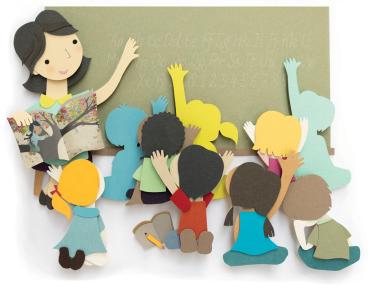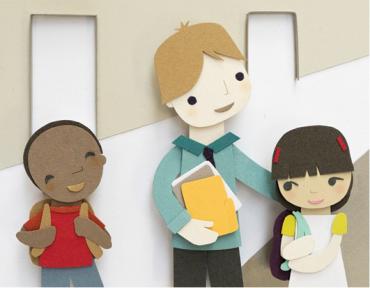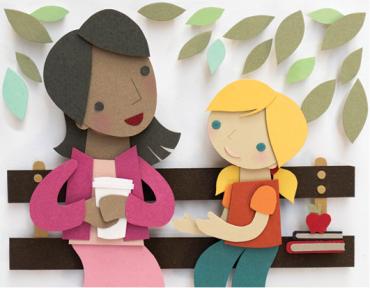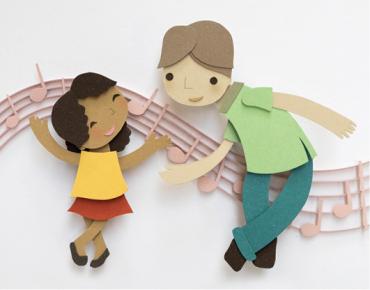Imagine this scenario: A first-year teacher escorts her third-graders from the school cafeteria to the classroom. She then asks them to join a reading circle in the front of the room—something they've practiced a lot. Jeremy, once again, refuses to come over. As a teacher, does she call him out? Offer him a reward for joining? Threaten consequences when he doesn't? Thirty students are ready to move on with their lessons and are waiting for a response from the teacher, but Jeremy is holding up the class. What should she do?
Now take a more seasoned teacher, his ethnicity and social class different from those of the students he teaches. A female student just said "F__ you!" and approaches him in a belligerent manner in the hallway. As a teacher, he does not want to just let this go, but he also knows that he needs to be careful not to escalate the situation or allow other students to think this behavior is appropriate. What should he do?
When teachers wonder "What should I do?" in response to challenging student behaviors, the answers are not as simple as they might seem. Although an individual teacher asks the question, the response must be nuanced enough to take into account the specific school and community. As in any field—not just in education—context is key.
Educators ask me all the time: "What do I do about the students in my class who just won't behave?" There's often a sense of urgency in their voice and a sense of desperation. I get it; these situations are uncomfortable, they're filled with emotions, and they detract from instruction. What we do know is that punitive discipline does not solve the problem—it exacerbates it.
Because of all sorts of challenges, many schools, particularly those in high-poverty districts, operate in a crisis management mode. Often our students display anger, frustration, and hurt in ways that feel (and often are) "defiant" or "disrespectful" to educators. There's no magic bullet, I tell them. The effectiveness of responses hinges not solely on individuals, but also on whether school cultures facilitate relationships between students and educators, open communication, provide opportunities for school-family collaboration, promote cultural awareness, and offer professional development to help teachers manage stress. In other words, we cannot place systemic responsibilities on the shoulders of individual educators.
What teachers can do also depends, at least in part, on external demands (e.g., discipline codes, principal expectations, time pressures on teaching content and testing) that can either facilitate or thwart positive resolutions of conflicts. For example, do school policies have some flexibility to account for the context of a situation and students' experiences? Are the expectations of a first-year teacher with less or no training in de-escalating student behavior the same as the expectations of a more seasoned teacher who has more experience and training with tough situations?
Perhaps, the real question in most cases is what are we or what is this system prepared to do? Framed differently, we can do a lot within a multitiered schoolwide approach in which behavioral challenges activate an existing system of positive support for both students and teachers. Over time, a disciplined, thoughtful approach to behavioral interventions can become sustainable despite individual strengths and weaknesses.
Empowering Educators
Prior to the birth of New York City's Positive Learning Collaborative, I spent nine years as a social worker and behavior specialist in District 75, the city's special education district. I worked extensively in classrooms with new teachers on how to handle behavior challenges they were facing. With a lot of trial and error, we figured out strategies together.
Often, teachers would come find me in the hallways and ask, "What do I do about this student who is running out of my room?" or "What do I do about that student who is picking on other kids and won't sit while I'm trying to teach?" It seemed clear that they didn’t have the preparation or support systems to deal with the many students coming in with complex histories of trauma, abject poverty, homelessness, and psychiatric vulnerabilities. I soon found out that the most effective teachers in working with challenging students had very positive relationships with them.
During my years in District 75, I started an initiative called STOPP (Strategies, Techniques, and Options Prior to Placement). As part of the initiative, I taught a four-day course called Therapeutic Crisis Intervention for Schools (TCIS), which uses a curriculum developed by Cornell University to reduce the number of students placed in restraints in residential treatment centers. We gained traction with the STOPP initiative by teaching the course to faculty from a few schools and helping their staffs build behavior support/climate teams that could address student behavior.
The TCIS course provides effective crisis intervention strategies that start to stabilize the school community by creating a common language around behavior, which then enables teachers and administrators to better connect with children. Educators practice self-awareness, active listening skills, and other strategies in order to prevent crises and teach students new coping skills for sorting out difficult feelings.
TCIS is an approach that empowers educators to feel a sense of greater control in dealing with the multifaceted problems students bring to school (e.g., psychiatric issues, trauma, poverty). We call upon participants to get in touch with their own beliefs and implicit biases about behavior and how our own experiences—as children, students, members of a community of faith, parents, etc.—shape our responses to behavior often in ways that escalate situations and produce negative outcomes for all concerned. (For more about what implicit bias is and how it works, see "Understanding Implicit Bias" by Cheryl Staats.)
Through the work of STOPP, I began to realize that this approach provided a framework with the potential to transform school climate and contribute to the success of our students. However, our resources were limited, and while we had strong administrative support from our superintendent in District 75, we had no room for expansion. I began to feel that the only way to embed this work into our school system was to align both partners and policy to a shared vision of positive approaches to school discipline.
Successful Collaboration
Throughout her more than two decades as vice president for special education for the United Federation of Teachers (UFT), the AFT's New York City affiliate, Carmen Alvarez has sought to support members in finding the most effective ways of responding to challenging behaviors. For most of her tenure, the only strategy she felt she had at her disposal was enforcing the student discipline code and using the "disruptive student" clause in our contract, which states that students with chronically disruptive behavior can be removed from the classroom for a single period, a single day, or up to four days. About five years ago, she started to hear about the work we were doing in District 75 and invited me to come to the union and give an overview of the STOPP initiative.
According to Alvarez, "Those who attended told me that this was exactly what they had been looking for and asked for more in-depth training." She worked with UFT President Michael Mulgrew to expand the number of people who could provide TCIS training in New York City. However, we knew from experience that the training was far from enough. We understood that we needed a multitiered system of support that addressed both schoolwide climate and individual students in order to be effective.
The concept of a multitiered framework of support is not new. For years, many school districts have provided training or support around positive discipline but with little evidence of improving the culture of punishment that pervades many New York City schools. I found that most educators were not directly trained in the strategies their schools were trying to implement.
For instance, Positive Behavioral Interventions and Supports (PBIS) is a tiered framework of positive behavior systems in a school. Success depends on having clear expectations that are taught, rehearsed, and reinforced consistently across settings. Teachers would often tell me "PBIS doesn't work"; however, in many cases, I would find that the school had a reward system that had no buy-in and no system for teaching the expected behaviors or analyzing the behavior data. I realized that relying on just one approach, or training only a few people in a school with little ongoing support and expecting sustainability, is a recipe for failure.
Designing a Sustainable Model
As interest in understanding student behavior and creating positive school climates continued to grow, Alvarez approached the New York City Department of Education's deputy chancellor, Corinne Rello-Anselmi, to see what more could be done, especially in terms of on-site support. Alvarez proposed the creation of a UFT-Department of Education consortium to provide New York City schools with a systemic, research-based approach to understanding, assessing, and supporting positive student behavior.
In spring 2012, The Atlantic Philanthropies awarded a three-year, $300,000 grant to the consortium that helped cover start-up costs, technology, and professional development. (For more about The Atlantic Philanthropies' work, see "A Powerful Partner" by Kavitha Mediratta.) With this grant, we have sought to support schools regarding student behavior. But before we agree to work with a particular school, we ask for a three-year commitment from that school. Since the grant does not cover the full cost of this work, each school must pay an annual sum that varies by staff size.
This was the beginning of what would become the Positive Learning Collaborative (PLC), an initiative jointly run by the UFT and the New York City Department of Education to help educators create positive school environments. As director, I work with a staff of four experienced behavior specialists who understand the toll that poverty, trauma, and stress take on our students and staff. The PLC's holistic approach focuses on teaching reflective and restorative practices. To that end, we coach educators to be mindful of their own internal dialogue and to teach students coping skills to deal with feelings such as anger and frustration.
Changing a school's culture can't happen without having the school's leader on board, and so we require that principals and union chapter leaders attend our four-day Cornell TCIS training first, and then we plan for all school-based staff—including teachers, administrators, paraprofessionals, cafeteria workers, and others—to attend over the course of a year. We provide ongoing workshops in restorative practices, social-emotional learning, and PBIS, among other programs based on the action plan developed in collaboration with school staff.
These individual action plans are geared toward each school's needs. Because we assess behavior and climate data often, we can help schools make adjustments accordingly. The PLC employs an in-depth, anonymous survey measuring major school climate indicators. We survey all school faculty every six months. My PLC staff then shares the data with school faculty, who are an integral part of the action planning process. Moreover, school teams receive support in using data to develop periodic benchmarks of success.
To build capacity and sustainability in every school we work with, we help school-based leadership teams develop behavior intervention systems and implement restorative practices and PBIS.
Training, however, is just a foundation. Every school has a PLC behavior specialist who visits the school at least twice a month and supports administrators, teams, and individual educators. We aim to reduce time students spend out of the classroom due to discipline issues. We also aim to build community through the use of restorative practices (e.g., emotional literacy and restorative circles, places for students and adults to reflect and rebuild relationships) in classrooms devoted to helping students regain their composure after a disruption or outburst.
In only its third year of existence, the PLC has shown remarkable success. Though the PLC began with six elementary schools in the 2013–2014 school year, it started the 2015–2016 school year with 14 schools, including two K–12 schools and one K–8. Thus far, the PLC has trained approximately 1,000 school staff members in TCIS and conducted more than 300 school visits for consultations, professional development, and direct classroom supports.
In the first year, the six schools that began with the PLC in 2013 saw a 46 percent reduction in suspensions and a 40 percent reduction in total disciplinary incidents. In addition, educators in these schools report improvements in school culture in terms of attitudes about school discipline and improved relationships between teachers and students, between teachers and principals, and among staff members themselves. That's real progress.
Moments of Opportunity
Teaching always centers on relationships. Sometimes, the best thing to do is just let an incident go until you have more information or until you can gather yourself emotionally. We know many of our students are vulnerable and suffering.
We can start to view moments of crisis as moments of great opportunity to understand our emotional triggers and those of our students. Doing so will enable us to reduce power struggles and optimize instructional time.
Paradoxically, it is precisely during the most difficult moments that we are most open to building stronger relationships. We can do some of this work as individuals in our everyday lives, but we can also have a great impact when an entire school staff engages in this effort together.
We encourage schools to establish a leadership team that tracks observable behaviors so educators can identify patterns and changes in order to prevent escalation and support students in need. The same data will also help a school see where the adults should make changes in the school environment. For example, if students are getting rowdy while waiting in a long line for lunch, it may make sense to change the intervals of when classes come into the cafeteria or how they line up for the food. Data can let us know where and when the incidents are most prevalent.
* * *
Let's return to Jeremy, who won't join the group after lunch: What should you do? If you have a relationship with Jeremy, you might walk over to him and ask, "Are you OK?" or "Will you walk over with me?" Or maybe it's as simple as walking up to him in the hallway on the way back from lunch and talking with him about his day. By doing this, you might find out that Jeremy is being teased by a classmate at lunch and is walking into the room feeling humiliated and alone. Or maybe something else is going on. You should try to find out, because understanding why this behavior is happening will guide your strategy for helping him.
For example, planned morning check-ins with students identified as experiencing family turmoil can make the difference between building positive relationships and the proverbial "putting out fires" throughout the day. In the PLC, we coach educators to try their best to determine the feelings and needs of each student. They can't do that if they don't have relationships with students first or the flexibility to employ differentiated ways of responding.
Ultimately, our goal with any school is not just to eliminate suspensions or violent incidents, but rather to create supportive and positive relationships that enable educators to teach and students to learn.
Dana M. Ashley is the director of the Positive Learning Collaborative, jointly run by the New York City Department of Education and the United Federation of Teachers. A social worker and behavioral specialist, she has worked with educators for more than a decade.
[illustrations by Liza Flores]




